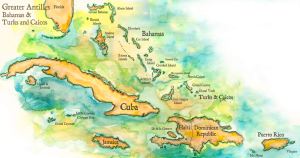STORYTELLER (MAMA): There is an island where rivers run deep…
STORYTELLER (TONTON): Where the sea sparkling in the sun earns it the name “Jewel of the Antilles”.
STORYTELLER (TI MOUNE): An island where the poorest of peasants labor —
STORYTELLER (DANIEL): And the wealthiest of the grandeshommes play.
STORYTELLER (ARMAND): Two different worlds on one island!
There is no designated “setting” indicated in the script for Once on This Island. This reference in the opening lyrics of the musical to the “Jewel of the Antilles” is the only direct allusion to where the story is set. Like any good storyteller’s work, the beginning narration of this play not only establishes where we are, but provides a sense of atmosphere and mood. Instead of “Once upon a time, in a kingdom far away,” we are on a specific island, a place that has earned a name for itself.
Although Once on This Island can be set on virtually any tropical island, this reference to the Jewel of the Antilles indicates that it is meant to be set on the island of Haiti. The Antilles is an archipelago (group of islands) bordered by the Caribbean Sea, the Gulf of Mexico, and the Atlantic Ocean. The Antillean islands are further divided into two groups: the Lesser Antilles, which consists of the Leeward Islands, the Windward Islands, and the Leeward Antilles; and the Greater Antilles, which includes Cuba, Jamaica, Puerto Rico, the Cayman Islands, and Hispaniola, which is subdivided into the Dominican Republic and, finally, Haiti.
Haiti has a complex and tumultuous history, one that deserves an entire post (or three or four) to itself in the future. For now, suffice to say it was originally colonized by the Spanish in the 15th century; in 1697, the nation ceded the western third of the Hispaniola island to the French; by the 17th century, Haiti (then Saint-Domingue) became known as the “Jewel of the Antilles,” the most prosperous colony in the world. During its most lucrative years, the colony, with its lush terrain and enormous working population, provided 80 percent of the world’s sugar, as well as coffee, rum, molasses, indigo, and more. The succes from the late 18th century revolution (the only successful slave revolution in the history of the world) was soon displaced by political turmoil, economic disaster, and disastrous international relations. But for that brief time in its history, Haiti, now the poorest country of the Americas, was once the envy of the world.
It is an intriguing choice on the Lynn Ahrens’ and Stephen Flaherty’s part that they immediately identify their story’s island with this antiquated nickname. It emphasizes how the world of the play is very much tied to its past;it is an island of both great beauty and devastating poverty, still proud of its past, but cognizant of how it grew out of slavery and oppression. The geography of Once on This Island is ambiguous, a fantastical place inhabited by both gods and humans. Within this same mythical world, however, there lies a brazen historical and political reality.

I am always sadden and curious about how Haiti’s economic status changed so drastically. From the wealthiest colony to the poorest country in the Western Hemisphere. Who or what killed Haiti is a subject of debate for some.
LikeLike